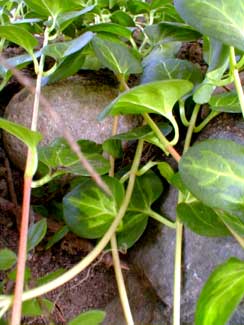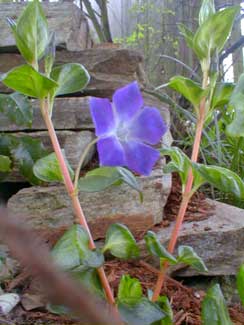
'Maculata' aka 'Surrey Marble'
Golden Blue-buttons,
Variegated Large-leaf Vinca or
Greater Perriwinkle
"Still am I sick of it, & tho', to-day,
I've gather'd young spring-leaves, & flowers gay
Or periwinkle & wild strawberry,
Still do I that most fierce destruction see."
-John Keats
1795-1821
1795-1821
There are several variegated forms of Vinca major. Leaves of 'Maculata' have golden-green centers, fading outward into the surrounding lime-green, & mid- to dark-blue flowers that first appear in March together with newly sprouting vines. The similar 'Variegata' aka 'Elegantissima' has white to creamy edges & paler than average blue flowers. The white edges are a bit wider for 'Sterling Silver' (with dark blue flowers) & wider still for 'Ralph Shugert' (with mid-blue flowers). A recently introduced sport of 'Maculata' is sold as 'WoJo's Gem' with an ivory-green center.
 'Maculata' was formerly a rare offering but now is offered semi-regularly in our better local nurseries. In England it is sometimes called 'Surrey Marble,' possibly because it originated as a sport in Surrey, though I'm not sure that's so, as I haven't been able to track down its specific origin. It is occasionally labeled Aureo-variegata (golden-variegated) or Golden Blue-buttons.
'Maculata' was formerly a rare offering but now is offered semi-regularly in our better local nurseries. In England it is sometimes called 'Surrey Marble,' possibly because it originated as a sport in Surrey, though I'm not sure that's so, as I haven't been able to track down its specific origin. It is occasionally labeled Aureo-variegata (golden-variegated) or Golden Blue-buttons.A hardy, vigorous creeper even in dryish shade, this variegated form of Vinca major is less aggressive than regular large-leaf vinca, & a bit slower to establish especially if used for a harsh location. It may need regular watering its first year if it is to get well established in harsh ground, but in a moderately nice location, it'll do well even without attention, to the point that there's some risk of it being rampant.
Its ideal is moderate to deep shade in well-draining soil, drought-hardy when established but preferring a bit of moistness. It dislikes bright sun & prone to leaf-scorch & spotting if in direct sunlight too much of the day, but is otherwise surprisingly heat-hardy showing no signs of summer stress when it's under trees.
The recurring suggestion it will do well even in full sun is only apt to be true furthest north in its acceptable gardening zones, or when the soil is kept evenly moist but not boggy, as otherwise it will lose most of its drought-hardiness in too much sun. My experience is that large-leaf vinca actually creep along the ground in the direction of shade. Their tendency to run wild can be controlled by placing them in a shady area completely surrounded by bright sun, since the vines are less inclined to travel any great distance through the sunniest patches.
However, with sufficient added watering, their hardiness is indeed so great that the unwanted sun wouldn't kill them. Still, to me their great appeal is they are useful in tough dark spots that don't hold moisture well, & the sunnier locations belong to plants for which there is no other choice.
It dislikes too much wetness, so is great planted in shadow under trees, the roots of which keep the area somewhat dry. We've stretched its dry shade tolerances to the maximum by placing starts of golden variegated vinca on a steep slope under a Douglas fir. The ground was too steep to work it really, as to work the surface would just encourage erosion, so the vinca has had to get started in small "holes" of enriched soil surrounded by the packed hillside. It is sharing part of this area with another potentially aggressive dry shade plant, Lirope muscari 'Lilac Beauty' The conditions are so harsh in this spot that even these two ultra-hardy dry-shade-plants will know restraint.
Merely refusing to die outright isn't enough; they have to look decent too. Both plants can be stunningly beautiful for areas where nothing much will grow, where even outright weeds have their limits. The trick with the vinca & the lirope flowering turf is to be sure we get sufficient water down that slope to keep them healthy during rainless periods so they hold their looks, though the greater hope is that they will be doing fine with minimal care.
To bloom spectacularly intermittently from spring until autumn, variegated vinca may require a light monthly liquid fertilizing for spring through early summer. But it could also be utterly neglected & still flower fairly well.
The leaves are less than half the size of our wild big-leaf vinca, hence sometimes called a dwarf variegated vinca, though the leaves are even so several times larger than the wee leaves of V. minor. The trailing vines are also much, much longer than for V. minor, so that it makes a superior groundcover for hanging off of ledges or dangling down the sides of box containers. It is often used as a hanging-basket vine because it will dangle from a basket some distance, with considerable beauty, alone or sharing the basket with something that grows a bit more upright.
The leaves are strongly evergreen here in Zone 8. And thanks to their yellow variegation & the red petioles (leaf stems), it is even colorful when not in flower, perfect for the winter garden's appearance. In Zone 6 it will be a die-back perennial much more restrained in its spread, since it has to start over each spring. In zone 5 or below it is apt to useful only as an annual.
Vincas in general are disease-free. The worst that is possible is stem-rot from being placed in soil that is too wet or drains poorly. It survives droughtiness much better than bogginess, growing most rapidly where soil is moist but well-draining, or growing well but not rapidly in a droughty spot.
The genus name "Vinca" is from Latin for "to bind" & dates at least to medieval times when wreathes of vinca were bound upon the heads of criminals for their march toward their execution, in contrast to the use of olive wreaths & laurel wreaths worn to signify victory or achievement.